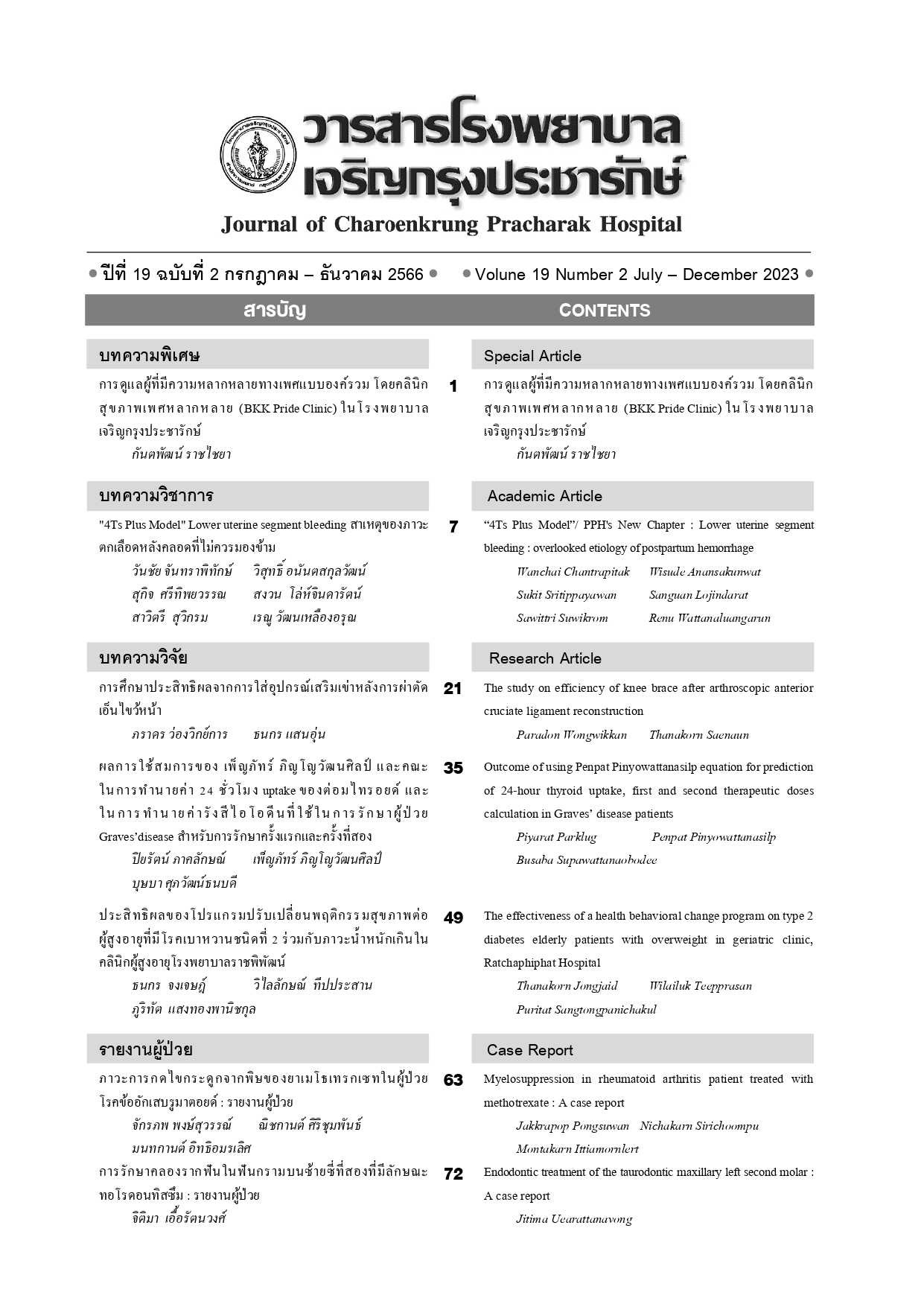"4Ts Plus Model" Lower uterine segment bleeding สาเหตุของภาวะตกเลือดหลังคลอดที่ไม่ควรมองข้าม
Main Article Content
บทคัดย่อ
บทคัดย่อ
บทนำ : ภาวะตกเลือดหลังคลอดเป็นปัญหารุนแรงที่อาจทำให้มารดาหลังคลอดเสียชีวิต ถึงแม้ว่าในช่วงศตวรรษ
ที่ผ่านมาการดูแลรักษาภาวะตกเลือดหลังคลอด (postpartum hemorrhage: PPH) จะสามารถดำเนินการได้ดีขึ้นในระดับหนึ่ง แต่กลับพบว่า อัตราการเกิดภาวะตกเลือดหลังคลอดจากมดลูกไม่หดรัดตัว (atonic PPH) กลับเพิ่มขึ้นในช่วง 2-3 ทศวรรษที่ผ่านมา แม้ในประเทศที่พัฒนาแล้ว จากการศึกษาพบว่า ภาวะตกเลือดหลังคลอดจากภาวะมดลูกส่วนล่างไม่หดรัดตัว (lower uterine segment atony : LUSA) เนื่องจากกล้ามเนื้อมดลูกบาง เป็นสาเหตุนำไปสู่ภาวะตกเลือดหลังคลอด เนื่องจากภาวะกล้ามเนื้อมดลูกขาดออกซิเจน (hypoxic uterine atony) เพื่อแก้ปัญหาดังกล่าว จึงได้มีการศึกษาการนำหัตถการกดมดลูกส่วนล่าง (lower uterine segment compression : LUSC) มาป้องกันภาวะตกเลือดหลังคลอดจากมดลูกส่วนล่างไม่หดรัดตัว
จากเดิมที่มีการใช้ตัวย่อ 4Ts ในการจำแนกสาเหตุของภาวะตกเลือดหลังคลอด แต่เนื่องจากยังไม่ครอบคลุมสาเหตุทั้งหมด ผู้นิพนธ์จึงได้แสดงรูปแบบสาเหตุการเกิดภาวะตกเลือดหลังคลอดเป็น 4Ts Plus Model มีการแยก uterine atony เป็น 2 แบบ คือ flaccid uterine atony และ hypoxic uterine atony ซึ่งหัตถการกดมดลูกส่วนล่างจะสามารถป้องกันและลดอัตราภาวะตกเลือดหลังคลอดได้ ร้อยละ 56.5 - 81.3 ขึ้นกับระยะเวลาของการกดมดลูกส่วนล่าง
สรุป : การค้นพบว่า ภาวะมดลูกส่วนล่างไม่หดรัดตัว (LUSA) เป็นสาเหตุหนึ่งของภาวะตกเลือดหลังคลอด การพัฒนารูปแบบ 4Ts Plus Model และการใช้หัตถการกดมดลูกส่วนล่าง (LUSC) เพื่อแก้ปัญหาดังกล่าวเป็น การเพิ่มทางเลือกใหม่ ในการดูแลรักษาผู้ป่วยที่มีโอกาสเกิดภาวะตกเลือดหลังคลอด ซึ่งจะส่งผลให้สามารถ ลดอัตราการเสียชีวิตมารดาหลังคลอดได้ทั่วโลก
Article Details

อนุญาตภายใต้เงื่อนไข Creative Commons Attribution-NonCommercial-NoDerivatives 4.0 International License.
เอกสารอ้างอิง
World Health Organization. SDG3: Ensure healthy lives and promote wellbeing for all at all ages. Geneva: WHO; 2015.
Azar M, Jennifer AH, Lily L, Robert M L, Joseph KS. Trends in postpartum hemorrhage from 2000 to 2009: apopulation-based study. BMC Pregnancy & Childbirth 2012;12:108.
Joseph KS, Rouleau J, Kramer MS, Young DC, Liston RM, Baskett TF. Investigation of an increase in postpartum haemorrhage in Canada. BJOG 2007;114:751-9.
Aflaifel N. Postpartum haemorrhage: new insights from published trials and the development of novel management options [dissertation]. Liverpool: University of Liverpool; 2015.
World Health Organization. WHO Recommendations for the PPH prevention and treatment of postpartum hemorrhage. Geneva: WHO; 2012.
Prata N, Bell S, Weidert K. Prevention of postpartum hemorrhage in low-resource setting: current perspectives Int J Womens Health 2013;5:737-52.
Kramer MS, Dahhou M, Vallerand D, Liston R, Joseph KS. Risk factors for postpartum hemorrhage: can we explain the recent temporal increase?. J Obstet Gynaecol Can 2011;33:810-9.
Ramanathan G, Arulkumaran S. Postpartum hemorrhage. J Obstet Gynaecol Can 2006;28:967-73.
Bateman BT, Berman MF, Riley LE, Leffert LR. The epidemiology of postpartum hemorrhage in a large, nationwide sample of deliveries. Anesth Analg 2010;1:110.
Prata N, Hamza S, Bell S, Karasek D, Vahidnia F, Holston M. Inability to predict postpartum hemorrhage: insights from Egyptian intervention data. BMC Pregnancy Childbirth 2011;11:97. doi: 10.1186/1471-2393-11-97.
Albayrak M, Ozdemir I, Koc O, Demiraran Y. Post- partum hemorrhage from the lower uterine segment secondary to placenta previa/accreta: successful conservative management with foley balloon tamponade. Aust N Z J Obstet Gynaecol 2011;51:377-80.
Yuksel H. A novel approach to primary lower uterine segment atony. Taiwan J Obstet Gynecol 2015;54: 452-4.
Panda B, Laifer S, Stiller R, Kleinman G. Primary atony of the lower uterine segment as a distinct cause of early postpartum haemorrhage: a case series and management recommendations. Journal of Obstetrics and Gynaecology 2009;29:628-32.
Wetta LA, Szychowski JM, Seals S, Mancuso MS, Biggio JR, Tita ATN. Risk factor for uterine atony/postpartum hemorrhage requiring treatment after vaginal delivery. Am J obstet gynecol 2013;209: 51.e1-6.
The American College of Obstetricians and Gynecologists. Postpartum Hemorrhage [Internet]. 2017 [cited 2023 May 25]. Available from: https://www.acog.org/clinical/clinical-guidance/practice-bulletin/articles/2017/10/postpartum-hemorrhage
Breathnach F, Geary M. Uterine atony: definition, prevention, nonsurgical management, and uterine tamponade. Seminars in Perinatology 2009;33;82-7.
Chantrapitak W, Srijanteok K, Puangsa-art S. Lower uterine segment compression for management of early postpartum hemorrhage after vaginal delivery at Charoenkrung Pracharak Hospital. J Med Assoc Thai 2009;92:600-5.
Habek D, Marton I, Prka M, Luetić AT, Vitić M, Jurković A. Surgical treatment of early postpartum hemorrhage caused by lower uterine segment atony [Internet]. 2021 [cited 2023 May 25]. Available from: https://www.researchsquare.com/article/rs-316854/v1
Li GT, Li GR, Li XF, Wu BP. Funnel compression suture: a conservative procedure to control postpartum bleeding from the lower uterine segment. BJOG 2016:123:1380-5.
Penotti M, Vercellini P, Bolis G, Fedele L. Compressive suture of the lower uterine segment for the treatment of postpartum hemorrhage due to complete placenta previa: a preliminary study. Gynecol Obstet Invest 2012;73:314-20.
Chantrapitak W, Anansakunwat W, Suwikrom S, Wattanaluangarun R. The correlation of lower uterine segment atony after delivery with atonic postpartum hemorrhage. Journal of Charoenkrung Pracharak Hospital 2019;15:1-13.
Althabe F, Therrien MNS, Pingray V, Hermida J, Lmezoglu AMG, Armbruster D, et al. Postpartum hemorrhage care bundles to improve adherence to guidelines: a WHO technical consultation. International Journal of Gynecology & Obstetrics 2019;148:290-9.
Chantrapitak W, Srijuntuek K, Wattanaluangarun R. The efficacy of lower uterine segment compression for prevention of early postpartum hemorrhage after vaginal delivery. J Med Assoc Thai 2011;94:649-56.
Anansakunwat W, Iamurairat W, Boonyoung P. Lower uterine segment compression for 20 minutes to prevent early postpartum hemorrhage. J Med Assoc Thai 2018;101:1151-6.
Chantrapitak W, Anansakunwat W, Suwikrom S, Wattanaluangarun R, Puangesaart S. Postpartum hemorrhage outcome in lower uterine segment compression maneuver: a 20-year experience in Charoenkrung Pracharak Hospital. J Med Assoc Thai 2018;101:495-500.
Hongranai S, Sopajaree C ,Ruangrit P, Dongnit W. Effect of duration of lower uterine segment compression immediately after placental delivery on amount of blood loss in normal delivery. Thai red cross nursing journal 2019;12:179-92.
Kangsanarak K. The outcome of lower uterine segment compression for 8 minutes at Nakhonnayok Hospital in normal vaginal delivery to prevent early postpartum hemorrhage. Chonburi Hospital Journal 2022;47:225-32.
Tewapitak P. The effects of lower uterine segment compression after Modified Crede’ maneuver on blood loss in the postpartum period. Journal of Health Science Research 2021;15:158-69.
Ruangrit P. The output of lower uterine segment compression and uterine massage for prevention of early postpartum hemorrhage after vaginal delivery. In Research administration division of Naresuan university, editor. Naresuan research conference 13: research and Innovation drivers of socio-economic; 2017 Jul 20-21; Naresuan university. Phitsanulok: Research administration division of Naresuan university; 2017. p. 742-51.
World Health Organization. WHO recommendations for the prevention and treatment of postpartum haemorrhage [Internet]. 2012 [cited 2023 May 25]. Available from: https://www.who.int/publications/ i/item/9789241548502
Alves ÁLL, Francisco AA, Osanan GC, Vieira LB. Postpartum hemorrhage: prevention, diagnosis and nonsurgical management. Rev Bras Ginecol Obstet 2020;42:776-84.


